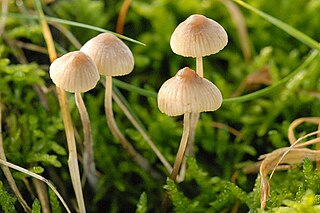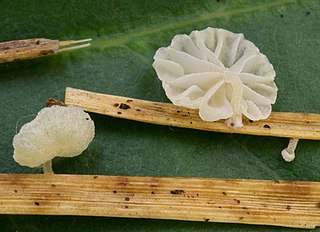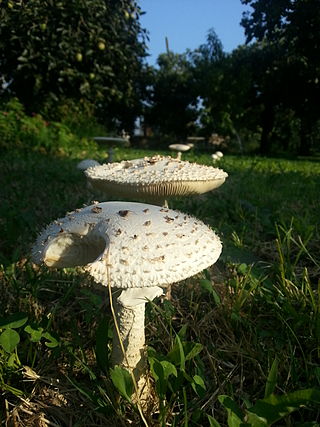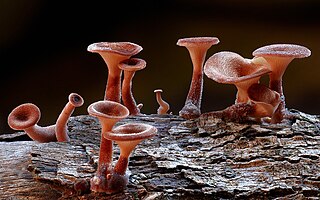Index Fungorum is an international project to index all formal names in the fungus kingdom. As of 2015 the project is based at the Royal Botanic Gardens, Kew, one of three partners along with Landcare Research and the Institute of Microbiology, Chinese Academy of Sciences.

The Marasmiaceae are a family of fungi in the order Agaricales. Basidiocarps are most frequently agarics, but occasionally cyphelloid. According to a 2008 estimate, the family contained 54 genera and 1590 species, but molecular research, based on cladistic analysis of DNA sequences, has led to a more restricted family concept, so that the Marasmiaceae included just 13 genera, and some 1205 species. It was reduced further down in 2020, to 10 genera and about 700 species.

Coprinopsis is a genus of mushrooms in the family Psathyrellaceae. Coprinopsis was split out of the genus Coprinus based on molecular data. The species Coprinopsis cinerea is a model organism for mushroom-forming basidiomycota, and its genome has recently been sequenced completely.

Coprinellus is a genus of mushroom-forming fungi in the family Psathyrellaceae. The genus was circumscribed by the Finnish mycologist Petter Adolf Karsten in 1879. Most Coprinellus species were transferred from the once large genus Coprinus. Molecular studies published in 2001 redistributed Coprinus species to Psathyrella, or the segregate genera Coprinopsis and Coprinellus.

Gymnopilus junonius is a type of mushroom-forming fungus in the family Hymenogastraceae. Commonly known as the spectacular rustgill, this large orange mushroom is typically found growing on tree stumps, logs, or tree bases. Some subspecies of this mushroom contain the neurotoxic oligoisoprenoid gymnopilin.

Psilocybe weraroa, formerly Weraroa novae-zelandiae, is a secotioid fungus in the family Hymenogastraceae. It is endemic to New Zealand, where it grows in native forests from rotting wood and woody debris. Despite its pouch-like form this species is closely related to Psilocybe cyanescens and Psilocybe subaeruginosa. As a bluing member of the genus Psilocybe it contains the psychoactive compounds psilocin and psilocybin.
Tulosesus heterosetulosus is a species of mushroom producing fungus in the family Psathyrellaceae.

Atheniella flavoalba, which has the recommended name of ivory bonnet in the UK, is a species of agaric in the family Cyphellaceae. The cap is initially conical, before becoming convex and then flat; it may reach up to 1.5 cm (0.6 in) across. The cap is ivory-white to yellowish white, sometimes more yellowish at the center. The tubular stems are up to 8 cm (3.1 in) long and 2.5 mm (0.10 in) thick, and have long, coarse white hairs at their bases. Atheniella flavoalba is found in Europe, the Middle East, and North America, where it grows scattered in pastures or in dense groups under conifers and on humus in oak woods.
Bogon is a village in Kale Township, Kale District, in the Sagaing Region of western Burma.

Resinomycena is a genus of fungi in the mushroom family Mycenaceae. The genus contains at least eight species found in North America, Europe and eastern Asia. This genus of small white to tan colored agarics is saprophytic and colonizes leaf litter, bark, small twigs and decaying monocot vegetation. The fruitbodies are small and resemble Mycena or Marasmius or Hemimycena and are distinguished by amyloid spores, poorly dextrinoid tissues, and the abundant oily, resinous cystidia on the pileus, lamellae edges and stipes. One recently described species, Resinomycena fulgens from Japan that is a synonym of Resinomycena japonica, has luminescent fruitbodies.

Saproamanita nauseosa is a species of agaric fungus in the family Amanitaceae. First described by English mycologist Elsie Maud Wakefield in 1918 as a species of Lepiota, it was named for its nauseating odor. The type specimen was found growing on soil in the Nepenthes greenhouse at Kew Gardens. Derek Reid transferred the species to Amanita in 1966, and then in 2016 the separate genus Saproamanita was created by Redhead et al. for saprophytic Amanitas and it was transferred to this new genus.

The genus Saproamanita contains about 24 species of agarics and is one of six genera in the family Amanitaceae, of which the similar Amanita is also a member. Saproamanita differs from Amanita in that its species are saprophytic, and not ectomycorrhizal.
Apostlethrips is a genus of thrips in the family Phlaeothripidae, first described by Laurence Mound and Kamb Minaei in 2006. The type species is Apostlethrips apostus. The members of this genus are found only in Australia, in the Northern Territory and Western Australia, at the base of grass tussocks where they are believed to feed on fungal hyphae.

Hypsizygus ulmarius, also known as the elm oyster mushroom, and less commonly as the elm leech, elm Pleurotus, is an edible fungus. It has often been confused with oyster mushrooms in the Pleurotus genus but can be differentiated easily as the gills are either not decurrent or not deeply decurrent. While not quite as common as true oyster mushrooms, they have a wide range globally in temperate forests. The mushrooms and vegetative hyphae of this species have been studied in recent years for their potential benefits to human health, and mycoremediation.

Hemimycena tortuosa, commonly known as the dewdrop bonnet, is a species of basidiomycete fungus of the family Mycenaceae, of the order Agaricales.
Calcarichelys is an extinct genus of protostegid turtle from the Late Cretaceous of the Selma Formation in Alabama, and possibly from Angola. It contains only one species, C. gemma.

Panus fasciatus is a species of fungus in the family Polyporaceae in the genus Panus of the Basidiomycota. P. fasciatus has a fruiting body in the shape of a funnel with a velvety texture, hence the nickname "hairy trumpet." When it was identified by D. Pegler of Kew, he created a subgroup of the Lentinus fungi, called Panus based on their hyphal systems. For this reason, Panus fasciatus is sometimes referred to as Lentinus fasciatus. Panus fasciatus has been described with numerous other names which were combined by Pegler in 1965.
Coprinopsis martinii is a species of mushroom producing fungus in the family Psathyrellaceae.

Coprinopsis nivea is a species of mushroom producing fungus in the family Psathyrellaceae. It is commonly known as the snowy inkcap.













